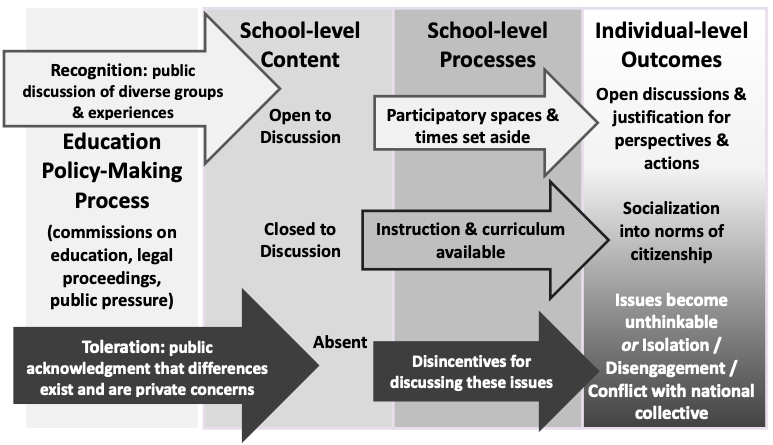Responses to Cultural Diversity in Botswana’s Schools
Summary
This article examines nation-state policies that have prioritized toleration of diversity over recognition through comparative case studies of three junior secondary schools in Botswana. Authors Bethany Mulimbi and Sarah Dryden-Peterson demonstrate how the schools, which varied in the ethnic composition of their students, teachers, and surrounding communities, responded differently to the reality of their multicultural student bodies.
The authors argue that schools could better develop students’ capacity for equal citizenship were they supported by national education policies and curriculum to recognize the cultural, historical, and linguistic diversity of Botswana’s ethnic minorities explicitly in schools.
Key Takeaways
We offer the following practical steps and actions based on this research below (click to expand).
+ For Policymakers
| INSIGHTS | ACTIONS | |
|---|---|---|
| There is a lack of national and school-level policies in Botswana that would foster, or even allow, discussion of historical inequalities between ethnic groups in schools or address ongoing tensions between these groups. | ➟ | Support schools through national education policies and curriculum to recognize multiple ethnic identities and contemporary effects of historical inequalities. Include students in discussion of these issues and how to best redress them. |
| Students’ continued experiences of discrimination and disrespect along ethnic lines demonstrate the limitations of developing equal opportunities for citizenship and participation through Botswana’s current policies and curriculum. | ➟ | In addition to enacting national policies of recognition, encourage school administrators’ development of school-level policies that respond to the unique needs of schools’ student bodies and equalize participation. |
| Contemporary education policy and social studies curriculum in Botswana are largely silent on inequalities or differing perspectives between minority and majority ethnic groups. The formal curriculum in junior secondary schools does not address contentious issues such as alternative historical understandings, economic and political inequalities between ethnic groups, or language rights. | ➟ | Treat language policies, inequalities and disrespect between ethnic groups, and alternative historical perspectives as topics that are open for discussion in schools. |

+ For Educators
| INSIGHTS | ACTIONS | |
|---|---|---|
| In schools, students wear uniforms, learn a prescribed national curriculum, and eat the same meals provided by the school. The most common cultural markers of ethnicity, such as dress, historical understandings, folklore, music, dance and cuisine, which can open deeper conversations, rarely become apparent in day-to-day interactions. | ➟ | Foster curiosity and openness about students’ lived experiences and a perspective that although students’ school routines are the same, their school community is made up of diverse groups who contribute to the community in different and meaningful ways. |
| Students at all schools in the study described experiences of disrespect and discrimination along ethnic lines at school and found few options within their schools to address these experiences. | ➟ | Bring attention to the reality of students’ experiences of mistreatment based on ethnicity by guiding class discussions that incorporate historical and current events relating to discrimination as entry points. |
| In one-on-one interviews, students said that students are ashamed to reveal their ethnicity for fear of being teased. Reports of bullying to school officials resulted in no follow-up. | ➟ | In collaboration with students, set class policies of follow-up for bullying, addressing situations as appropriate in class. Seek support from the school administration for consistent practices that provide a safe environment in which students are heard and see their concerns addressed. |
+ For Researchers
| FURTHER RESEARCH IS NEEDED TO EXAMINE: | ||
|---|---|---|
|
||
| Additional reading | ||

